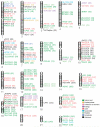An atlas of genetic influences on human blood metabolites
- PMID: 24816252
- PMCID: PMC4064254
- DOI: 10.1038/ng.2982
An atlas of genetic influences on human blood metabolites
Abstract
Genome-wide association scans with high-throughput metabolic profiling provide unprecedented insights into how genetic variation influences metabolism and complex disease. Here we report the most comprehensive exploration of genetic loci influencing human metabolism thus far, comprising 7,824 adult individuals from 2 European population studies. We report genome-wide significant associations at 145 metabolic loci and their biochemical connectivity with more than 400 metabolites in human blood. We extensively characterize the resulting in vivo blueprint of metabolism in human blood by integrating it with information on gene expression, heritability and overlap with known loci for complex disorders, inborn errors of metabolism and pharmacological targets. We further developed a database and web-based resources for data mining and results visualization. Our findings provide new insights into the role of inherited variation in blood metabolic diversity and identify potential new opportunities for drug development and for understanding disease.
Figures





Comment in
-
Translational genomics: A network of the human metabolome.Nat Rev Genet. 2014 Jul;15(7):442. doi: 10.1038/nrg3758. Epub 2014 May 28. Nat Rev Genet. 2014. PMID: 24866757 No abstract available.
References
-
- Garrod AE. Inborn Factors in Disease. Oxford University Press; 1931.
-
- Sabatine MS, et al. Metabolomic identification of novel biomarkers of myocardial ischemia. Circulation. 2005;112:3868–75. - PubMed
Online References
-
- Wichmann HE, Gieger C, Illig T. KORA-gen--resource for population genetics, controls and a broad spectrum of disease phenotypes. Gesundheitswesen. 2005;67(Suppl 1):S26–30. - PubMed
-
- Abecasis GR, Cherny SS, Cookson WO, Cardon LR. Merlin--rapid analysis of dense genetic maps using sparse gene flow trees. Nat Genet. 2002;30:97–101. - PubMed
-
- Kutalik Z, Whittaker J, Waterworth D, Beckmann JS, Bergmann S. Novel method to estimate the phenotypic variation explained by genome-wide association studies reveals large fraction of the missing heritability. Genet Epidemiol. 2011;35:341–9. - PubMed
Publication types
MeSH terms
Grants and funding
LinkOut - more resources
Full Text Sources
Other Literature Sources
Medical

